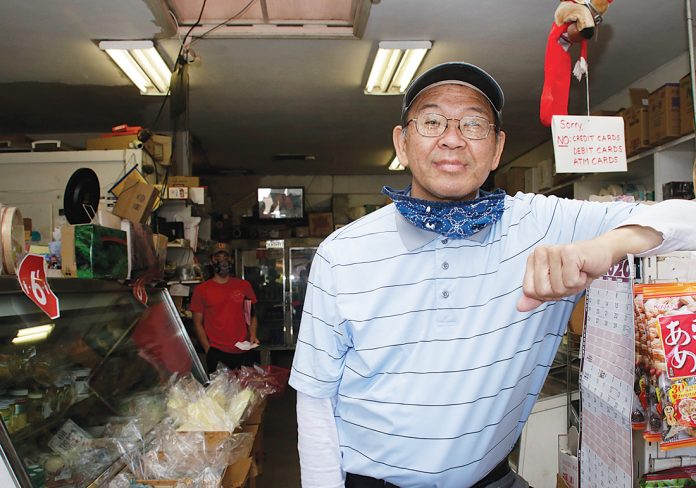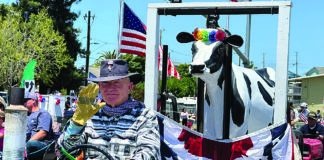
Editor’s note: This is the first entry of a weekly four-part series about the Pajaro Valley’s Japanese community. The series will culminate on Aug. 14, coinciding with this year’s celebration of the Obon Festival, a cultural and religious Japanese event honoring one’s ancestors.
By Hugh McCormick, Special to the Pajaronian
WATSONVILLE—The deli counter that once teemed with the freshest seafood in the southern reaches of Santa Cruz County is now stocked with pickled ginger, miso paste, yan noodles and fish cakes. But not much else has changed at Watsonville’s diminutive, family-run Yamashita Grocery (or Yamashita Market) in the past 70 years.
With moon-shaped glasses, a weathered grey fanny pack, floppy “Maui” hat, and a hidden, but clearly evident smile under his red bandana, Goro Yamashita carefully navigated through a labyrinth of boxes and shelves, taking time to greet colorfully-masked-customers as they walked through the weathered metal doors of his store on Union Street.
It’s officially “Tofu Day” at Yamashita Grocery, so Goro, his two sisters and his cousin Toshi are all busy, in a whirl of constant motion. They ring up customers on an ancient cash register, expertly moving—swiftly and in sync—through a tiny space not much larger than the average garage.
The Yamashita clan—tight-knit as ever—has been doing the same thing, the same way, for their entire lives.
“Customers have been coming to us for fresh tofu, mochi, manju, and fish for decades,” said Goro, who added that 99% of what they sell is Asian, and 95% is Japanese.
Goro, now the proud owner/proprietor of Yamashita Grocery, has spent his entire life in Watsonville. He grew up in the small agricultural city, helping his mother, who was born locally, and his father, who emigrated from Japan at age 13, at his family’s store each day after school (he attended Watsonville High School). In the decades before Goro’s mom and dad took the helm, “Aunt Mary” Yamashita ran things, beginning in 1928.
“My dad being the oldest child, felt like it was his responsibility to take care of things and run the grocery,” Goro said as he expertly cut through a thick block of milky, white tofu and reminisced. “He loved this store. Number one was the store, number two was his bonsai plants, and number three was his family. It’s been important to us all to keep the store going.”
Working at and running the grocery has been a more-than-important Yamashita tradition for almost a century. The store is a holdout—one of the few Japanese businesses in a city rich with Japanese history and tradition.
“We’re the last family-owned Japanese store around,” Goro said. “Other stores are more Americanized… like little Safeways. There used to be many, many more mom-and-pop Japanese businesses in Watsonville. But we’re the only one now. It’s sad.”
With a weathered facade—peeling pink-ish paint, rusty brown screen doors, and a small paper American flag in the window—Yamashita Grocery has no signage whatsoever. You could easily drive by its Union Street location hundreds of times without noticing it was there. It’s very location—next to a taqueria and across the street from a McDonald’s—is emblematic of the way that Watsonville has changed over the years.
Japanese immigrants arrived in Watsonville as early as 1892. California was rapidly becoming the fruit and vegetable basket of the United States, and cheap farm labor was needed to keep the immensely profitable ag-machine running. A paltry 4% of fruit and vegetable crops originated in California in 1879. Three decades later, the Golden State was pumping out over half of the nation’s produce.
Pajaro Valley’s white farmers relied on Chinese field workers, who worked for a pittance for decades. But the Chinese Exclusion Act of 1882 forced farmers to find alternative sources of field labor, and ended up opening the door for thousands of Japanese immigrants.
A trickle, and then a wave, of Japanese workers—mostly young, unmarried men from smallish farms and villages—began arriving in the Pajaro Valley around the turn of the century. Many of the immigrants were second and third sons, who by Japanese primogeniture, didn’t inherit their family’s business and property in their home country.
When the first known Japanese immigrant, Sakuzo Kimura, arrived in Watsonville in 1885, he used the little English he knew to organize a labor force. Tending mostly apples, strawberries and sugar beets, the Japanese transplants filled the labor-vacuum left by the Chinese.
Chasing the “American Dream” and gainful employment in the area’s lush fields and vibrant orchards, Japanese workers quickly earned a reputation as “industrious, hard working, and reliable.” Their own Emperor, Meiji, decreed that while representing Japan in America they work diligently and fulfill any and all contracts.
Japanese immigrants played a pivotal role in creating today’s “Salad Bowl of the World.” They provided not only cheap and necessary labor, but also a unique agricultural approach—with expertise and ingenuity in areas such as irrigation, mulching, seed selection and soil preparation.
Sandy Lydon, Historian Emeritus at Cabrillo College, has written extensively on the history of Asian—mainly Japanese—immigrants in the Monterey Bay. His award-winning book, “The Japanese in the Monterey Bay Region,” is the first-ever regional treatment of the Monterey Bay’s Japanese immigrants. It begins with the earliest Japanese immigration into the region in the 1880s, and continues through the 1980s.
“The Japanese were the best farmers in the world,” Lydon said. “There’s very little arable land in Japan so they used every bit of land available—no wasted corners. The cultivation techniques they developed required organization and cooperation, and they were attentive and creative. They can make do with small parcels. They brought this to the Pajaro Valley.”
Japanese immigrants were able to cultivate small acreages intensively, with impressive per-acre yields and returns. The Valley’s impressive fruit and vegetable cultivation, as it stands today, owes much to the creativity, flexibility and cooperation of Japanese immigrants.
Close to 700 Japanese called Watsonville “home” in 1910. Many lived in “Japan Town”—a vibrant community south of the Pajaro Bridge—complete with bath houses, labor clubs, two churches, a laundry, medical doctors, a shoe store, photo studios, and general merchandise and grocery stores. The impact of Watsonville’s Japanese immigrant population continued to grow, in size and scope, from there.
The area’s Japanese flourished in the face of rampant discrimination, and a variety of anti-assimilation laws. As was done to the Chinese in 1882, it was decreed in 1924 that Japanese migrants couldn’t marry whites, couldn’t become citizens of the United States and couldn’t own property. First-generation Issei immigrants formed a Japanese Association for their mutual benefit. With a secretary and required monthly dues, the association functioned as a much-needed bank—other financial institutions wouldn’t lend Japanese immigrants money.
During the late 19th and early 20th centuries tabloids, newspapers, entertainment (movies), patriotic organizations (Elks Clubs, Sons of the Golden West), churches and politicians regularly spewed hate toward the immigrants such as the “Japanese is an alien race which can never be assimilated into the American way of life.” Amidst that kind of prejudice, the area’s Japanese community banded together, unified and solidified.
To show their patriotism and appreciation of their new home, and new country, the Japanese Association participated in Fourth of July parades throughout the 1930s.
•••
In next week’s entry, we dive into a dark period in our country’s history: Executive Order 9066.












